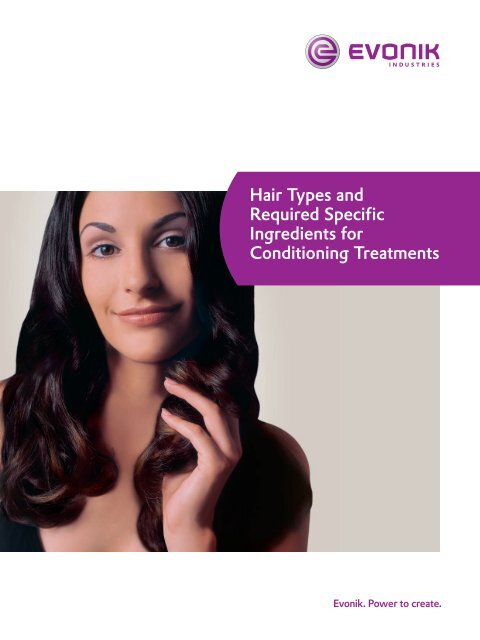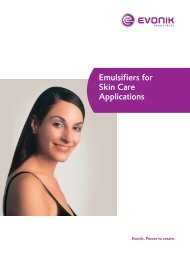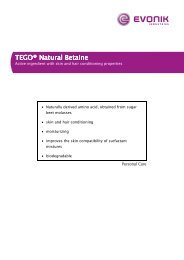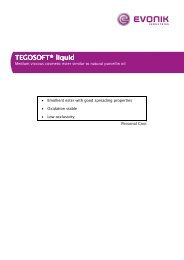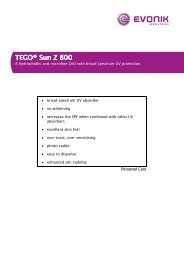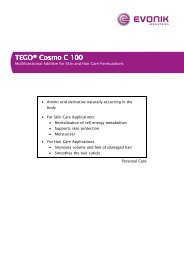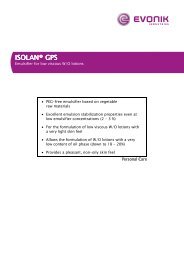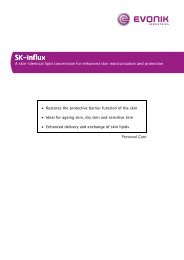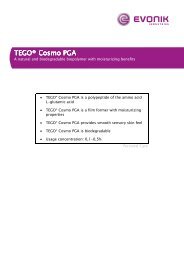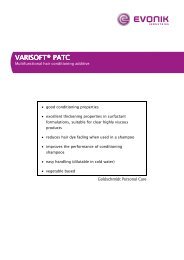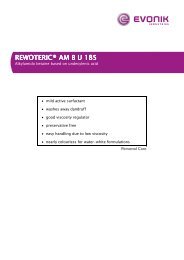Hair Types and Required Specific Ingredients for Conditioning ...
Hair Types and Required Specific Ingredients for Conditioning ...
Hair Types and Required Specific Ingredients for Conditioning ...
You also want an ePaper? Increase the reach of your titles
YUMPU automatically turns print PDFs into web optimized ePapers that Google loves.
<strong>Hair</strong> <strong>Types</strong> <strong>and</strong><br />
<strong>Required</strong> <strong>Specific</strong><br />
<strong>Ingredients</strong> <strong>for</strong><br />
<strong>Conditioning</strong> Treatments
<strong>Hair</strong> <strong>Types</strong> <strong>and</strong> <strong>Required</strong> <strong>Specific</strong> <strong>Ingredients</strong> <strong>for</strong><br />
<strong>Conditioning</strong> Treatments<br />
An emerging market trend is to differentiate hair care products by specific hair type, <strong>for</strong> example <strong>for</strong> fine hair, <strong>for</strong> colored hair or<br />
<strong>for</strong> grey/white hair. With regard to this we differentiated the hair types <strong>and</strong> their special needs <strong>for</strong> conditioning improvement. The<br />
main tasks were to define the per<strong>for</strong>mance criteria <strong>and</strong> identify the most suitable conditioning additive <strong>for</strong> a particular need.<br />
1. Global <strong>Hair</strong> <strong>Types</strong><br />
For the selection of the right product, a distinction has first to be made between the various hair types. <strong>Hair</strong> can be differentiated<br />
according to hair diameter into fine (thin), medium <strong>and</strong> thick hair. The mean fiber diameter of human scalp hair is 29 – 125 µm [1].<br />
By treating the hair with different cosmetic or chemical treatments or by natural changes (hair becomes grey), the quality of the<br />
hair is altered. Figure 1 details the various hair types, which can be differentiated <strong>for</strong> their specific hair care needs.<br />
<strong>Hair</strong> Fiber Diameter<br />
Fine/thin<br />
(29 – 49 μm)<br />
Medium (Caucasian)<br />
(50 – 90 μm)<br />
<strong>Hair</strong> Quality<br />
based on chemical treatment<br />
or natural change<br />
• virgin (= not altered)<br />
• permed<br />
• dyed<br />
• virgin<br />
• grey/white<br />
• permed<br />
• dyed<br />
Thick/coarse<br />
(91 – 125 μm)<br />
straight<br />
(Asian)<br />
curly<br />
(South American/Mediterranian)<br />
curly<br />
(African)<br />
• virgin, grey/white<br />
• permed<br />
• dyed<br />
• virgin, grey/white<br />
• straightened<br />
• dyed<br />
• virgin, grey/white<br />
• straightened<br />
• dyed<br />
Figure 1: Global hair types<br />
2
Thin/fine <strong>and</strong> medium hair<br />
Thin/fine <strong>and</strong> medium hair types are both represented by the Caucasian type, which is the most common<br />
hair type in Europe. The mean diameter of adult Caucasian hair diameter is 50 – 90 µm; infant hair has a<br />
diameter of about 31 µm [1].<br />
Thin or fine hair may occur mostly in the northern part of Europe. The disadvantages of this hair type are<br />
generally that the hair is often too smooth (like children’s hair), has a poor volume <strong>and</strong> exhibits “fly-away”,<br />
especially in dry climates. If the hair fibers are electrostatically charged by combing or other means, it can be<br />
nearly impossible to style the hair. Caucasian hair generally is just slightly curled; there<strong>for</strong>e a common<br />
cosmetic treatment is perming. Bleaching <strong>and</strong> dying are also common treatments on this hair type.<br />
With increasing age, a natural change occurs in the hair. The hair turns grey or white <strong>and</strong> becomes more rigid<br />
<strong>and</strong> slightly thicker. There<strong>for</strong>e grey or white hair is not classed as fine hair, but rather as medium hair.<br />
Thick/coarse hair<br />
<strong>Hair</strong> types with a wider diameter are represented by the Asian, the South American/Mediterranian <strong>and</strong> the African hair<br />
types. Within this group the main distinction is the <strong>for</strong>m of a cross section of the hair fibers. While Asian hair exhibits a<br />
circular cross section, the other hair types are more elliptic. An African hair fiber is most elliptical, appearing as a b<strong>and</strong>.<br />
This structural <strong>for</strong>m renders African hair more susceptible to mechanical damage. The degree of elliptic cross section<br />
correlates with the curliness.<br />
The Asian hair type is typically straight; there<strong>for</strong>e a common cosmetic treatment is permanent waving. In Asia,<br />
bleaching <strong>and</strong> dying are also widespread treatments. In the Asian markets, hair coloring is generally done to lighten the<br />
hair color. Grey coverage, which had not been common, is gaining in popularity.<br />
The South American <strong>and</strong> Mediterranean hair types are quite curly. Here, straight hair with a low volume is desired.<br />
There<strong>for</strong>e, permanent straightening is an often-used cosmetic treatment. Permanent straightening is from a chemical<br />
point of view a very similar process to waving. There<strong>for</strong>e hair care needs are very similar <strong>for</strong> both types of damage.<br />
The African hair type is very curly. If hair is very curly, this property dominates other fiber properties <strong>and</strong> controls hair<br />
effects [1], <strong>and</strong> needs there<strong>for</strong>e very specific cosmetic treatments. When straight hair with low volume is desired,<br />
chemical straighteners, which can damage the hair, are employed. Further damage is inflicted if the hair is subsequently<br />
bleached or dyed to achieve a specific color.<br />
3
2. <strong>Conditioning</strong> Needs <strong>for</strong> Different <strong>Hair</strong> <strong>Types</strong><br />
<strong>Hair</strong> conditioning products have to provide a wide variety of different properties. The properties that are specific to a need are<br />
claimed on the package, others are simply implied. The most important properties that need to be addressed in a hair conditioner are:<br />
• detangling/wet comb<br />
• wet feel<br />
• dry comb improved (lower <strong>for</strong>ce)<br />
• dry comb reduced (higher <strong>for</strong>ce, provides hold of the style)<br />
• dry feel<br />
• gloss/shine<br />
• style retention (reduced curl droop)<br />
• straightening effect (weighing down, poor volume)<br />
• volume/body<br />
• antistatic effect<br />
• color protection<br />
• hair strengthening properties<br />
Looking into this list of conditioning effect one may think, that all of them are requested in any case. This is true, but<br />
nevertheless, the most important parameters do differ between specific hair types. Figure 2 shows an overview about<br />
the specific conditioning needs of the various hair types, which already have been described in chapter 1. The crosses<br />
symbolise the “primary” importance of need, the circles symbolise the “secondary” need <strong>for</strong> property improvement.<br />
Improvement of detangling/wet combability is important <strong>for</strong> all hair types, because this property is immediately<br />
perceived by the consumer.<br />
The improvement of the wet feel is mostly important <strong>for</strong> colored hair which feels very hard <strong>and</strong> rough when wet.<br />
The parameter “dry combing” has to be differentiated: fine hair does not necessarily need reduced dry combing <strong>for</strong>ces,<br />
because this would lead to a reduced volume related to the lower friction between the single fibers. But thick hair <strong>and</strong><br />
curly hair types generally do need to be smooth in the dry stage, especially if they are chemically treated.<br />
Dry feel is also one of the parameters, which are detected by the consumers immediately <strong>and</strong> is there<strong>for</strong>e important <strong>for</strong><br />
all hair types.<br />
Gloss/shine is mostly important <strong>for</strong> straight hair, because curly hair has a structure related low shiny appearance.<br />
Colored hair needs to have a gloss improvement.<br />
An improved hold of the hairstyle is mostly interesting <strong>for</strong> fine <strong>and</strong> normal hair.<br />
This plays also a role in minimizing the frizzyness of curly hair. For this type of hair, defined curls or even straight styled<br />
hair is desired.<br />
A straightening effect is desired <strong>for</strong> the thick hair type. The opposite, an increased volume/body is desired <strong>for</strong> fine<br />
<strong>and</strong> normal hair with exception of the permed types (because the perming treatment already increase the volume).<br />
An antistatic effect is mostly interesting <strong>for</strong> the chemically treated fine <strong>and</strong> normal hair because of the lowered<br />
isoelectric point of the hair keratin.<br />
An improved color protection is essential <strong>for</strong> colored hair, esp. <strong>for</strong> the very modern intensely red colored hair. The red<br />
pigments are much smaller than others <strong>and</strong> there<strong>for</strong>e may be washed out more easily.<br />
The table in Figure 2 summarizes the specific conditioning needs of the various hair types.<br />
4
<strong>Hair</strong> type<br />
Properties<br />
Fine<br />
Detangling/wet comb<br />
Wet feel<br />
Dry comb improved (lower <strong>for</strong>ce)<br />
Dry comb reduced (higher <strong>for</strong>ce)<br />
Dry feel<br />
Gloss/shine<br />
Straightening effect (weighing down)<br />
Volume/body<br />
Antistatic effect<br />
Hold of hairstyle (reduced curl droop)<br />
virgin O X X X O<br />
permed O O O X<br />
dyed O X O X X O X X X<br />
Normal (Caucasian)<br />
virgin O O X O<br />
grey/white O O X O<br />
permed O O X O O<br />
dyed O X O O X O O O X<br />
Thick/coarse<br />
straight (Asian)<br />
virgin, grey/white O O O O O X<br />
permed O O X O O<br />
dyed O X X O X X O<br />
curly ( South American, North African)<br />
virgin, grey/white X O O O X<br />
straightened X O X O X X<br />
dyed X X O O X O<br />
curly (Ethnic)<br />
virgin, grey/white O O O X X<br />
straightened X O X X X X<br />
dyed O X O X X O<br />
Wash fastness/color protection<br />
X = essential; O = important<br />
Figure 2: <strong>Conditioning</strong> properties relevant <strong>for</strong> specific hair types<br />
5
3. Test Methods <strong>for</strong> Determination of<br />
<strong>Conditioning</strong> Property Improvement<br />
In Figure 3 an overview of the test methods used to assess the conditioning properties of conditioning agents is given.<br />
These methodologies can be differentiated into technical measurements <strong>and</strong> sensory assessments.<br />
Technical measurements on hair swatches<br />
• Combing <strong>for</strong>ce measurements<br />
• Body/volume measurements<br />
• Curl retention tests<br />
• Antistatic test:<br />
Fly away measurements<br />
• Measurements of the wash fastness of<br />
semipermanent/permanent dyes<br />
Sensory methods<br />
• <strong>Hair</strong> swatch tests<br />
• Technical tests done by hairdresser (Salon tests)<br />
• Consumer tests<br />
Figure 3: Test methods<br />
Technical measurements<br />
One of the most common measurements is the determination of the combing <strong>for</strong>ces. This method allows measuring<br />
<strong>for</strong>ces, which occur while combing in a high sensitive manner.<br />
To do the body/volume measurements, the hair swatches are pulled through a ring. The <strong>for</strong>ce measured in this design<br />
is mainly influenced by the compression of the hair tress into this ring [2].<br />
The curl retention test (Figure 4) is normally used <strong>for</strong> styling products. We did this test <strong>for</strong> the differentiation of<br />
conditioners. The change of humidity directly effects the water content of hair <strong>and</strong> plastifies the hair cortex. The<br />
conditioners may make the surface more hydrophobic, reducing the absorption of atmospheric water. This<br />
hydrophobizing effect keeps the hairstyle more stable <strong>and</strong> is also important <strong>for</strong> curly hair in order to avoid frizzyness.<br />
To measure the antistatic properties of conditioners, we use the shadow contour method (Figure 5). Under defined<br />
climatic conditions the hair swatch is fixed in front of a centric measuring scale. By using a light source, the shadow<br />
image is created <strong>and</strong> the spreading be<strong>for</strong>e <strong>and</strong> after charging by defined combing is measured.<br />
The measurement of the color protection or wash fastness can be done by using a spectrophotometer. <strong>Hair</strong> swatches<br />
are dyed with a permanent or a semipermanent dye <strong>and</strong> after drying the CIE-L*a*b-colour values are measured. This is<br />
done again after a defined number of treatments (shampooing <strong>and</strong>/or treatment with a rinse). The lower the difference<br />
of the color values is, the better is the wash fastness property of the tested product.<br />
6
Curl retention [%] = (L - Lt/L - L0) * 100<br />
Curl length at t0 after drying at 50 % rel. humidity<br />
Curl length after 2 hours at 70 % rel. humidity<br />
Figure 4: Curl retention test<br />
Figure 5: Fly away effect measuring method<br />
Sensory methods<br />
Technical methods are useful in screening products <strong>and</strong> <strong>for</strong>mulations, but sensory methods should be used to confirm<br />
the findings. When per<strong>for</strong>med by trained personnel, sensory use data will closely parallel consumer preferences.<br />
<strong>Hair</strong> swatch test<br />
A sensory hair swatch test with st<strong>and</strong>ardised damaged hair is mostly used as a screening. By using a defined scoring<br />
system, we rate the following properties by sensory assessment: detangling/wet comb, wet feel, dry comb, dry feel,<br />
volume <strong>and</strong> gloss.<br />
Salon tests (half head tests) done by hairdressers<br />
One of the most important conditioning tests is the half head test. Here, the hair of a test subject is treated with two<br />
different <strong>for</strong>mulations, one on the left <strong>and</strong> one on the right of the head. The hairdresser is able to make a direct<br />
comparison of properties like ease of distribution, rinsability, wet <strong>and</strong> dry comb, wet <strong>and</strong> dry feel, drying time, gloss,<br />
volume/body, antistatic behaviour, bounce, build up, etc. Generally a defined scoring system is used.<br />
7
4. <strong>Conditioning</strong> Agents<br />
The product line Personal Care of Evonik offers a wide range of conditioning agents <strong>for</strong> rinses <strong>and</strong> intensive treatment products.<br />
This range consists of organic based as well as of silicone based conditioning agents. Figures 6 <strong>and</strong> 7 give an overview of the most<br />
important products that were differentiated by conducting several tests. One of the aims of this study was to find possible synergistic<br />
effects between the organic <strong>and</strong> the silicone based products.<br />
Quat-Type Trade name INCI name<br />
Monoalkyl<br />
H 3<br />
C<br />
R<br />
+<br />
N CI -<br />
H 3<br />
C CH 3<br />
R=C 16<br />
VARISOFT ® 300 Cetrimonium Chloride<br />
R=C 22<br />
VARISOFT ® BT 85 Behentrimonium Chloride<br />
O +<br />
H 3<br />
C CH 2<br />
CH 2<br />
OCR<br />
Esterquat N<br />
CI -<br />
R=C 17<br />
H 3<br />
C CH 2<br />
CH 2<br />
OCR<br />
O<br />
VARISOFT ® EQ 65<br />
Pellets<br />
Distearoylethyl Dimonium<br />
Chloride, Cetearyl Alcohol<br />
Dialkyl<br />
H 3<br />
C<br />
H 3<br />
C<br />
N<br />
R<br />
R<br />
+<br />
CI -<br />
R=C 16<br />
VARISOFT ® 432 PPG Dicetyldimonium Chloride<br />
R=C 18<br />
VARISOFT ® TA 100 Distearyldimonium Chloride<br />
+<br />
CH 3<br />
O<br />
Imidazolinium N N CH R=Palm VARISOFT ® 2<br />
CH 2<br />
NHCR CH 3<br />
OSO -<br />
3<br />
W 575 PG Quaternium-87<br />
R<br />
O CH +<br />
3<br />
Amidoquat RCNHCH R=Palm VARISOFT ® 2<br />
CH 2<br />
CH 2<br />
N CH 3 CI -<br />
PATC Palmitamidopropyltrimonium<br />
CH 3<br />
Chloride<br />
O<br />
CH 3<br />
Amidoamine RCNHCH R=C 17<br />
TEGO ® 2<br />
CH 2<br />
CH 2<br />
N<br />
Amid S 18 Stearamidopropyl Dimethylamine<br />
CH 3<br />
Figure 6: Tested cationics<br />
8
CH 3<br />
CH 3<br />
CH 3<br />
CH 3<br />
H 3<br />
C Si O Si O Si O Si O Et<br />
CH 3<br />
CH 3<br />
(CH 2<br />
) 3<br />
(CH 2<br />
) 3<br />
m<br />
O NH 2<br />
O<br />
OH<br />
O CH 3<br />
CH 3<br />
CH 3<br />
CH 3<br />
O<br />
R N N<br />
+<br />
O Si O Si O N<br />
+<br />
N R<br />
H CH CH CH 3<br />
OH CH 3<br />
H<br />
3 3<br />
n<br />
CH 2<br />
CH 2<br />
O<br />
CH 2<br />
CH<br />
O<br />
x<br />
CH 3<br />
Y<br />
Siloxane quat:<br />
Quaternium-80<br />
(ABIL ® Quat 3272, liquid, 50 % active<br />
ABIL ® Quat 3474, viscous, 97 % active)<br />
CH 3<br />
n<br />
Amino functional siloxane:<br />
Methoxy PEG/PPG 7/3 Aminopropyl Dimethicone<br />
(ABIL ® Soft AF 100, liquid, 100 % active)<br />
Figure 7: Tested silicones<br />
Organic based cationics<br />
Two monoalkyl quats with different C-chain-length were tested: one of the most common conditioning agents<br />
Cetrimonium Chloride (“CTAC”, VARISOFT ® 300), which functioned in all our tests as a st<strong>and</strong>ard, <strong>and</strong> the more<br />
hydrophobic VARISOFT ® BT 85 (Behentrimonium Chloride).<br />
In 2007 a new environmental friendly cationic was introduced. VARISOFT ® EQ 65 Pellets is an ester quat based on<br />
high purity stearic acid <strong>and</strong> is compounded with Cetearyl Alcohol. It is a readily biodegradable conditioning agent with a<br />
high flash point.<br />
Furthermore two dialkyl quats were tested:<br />
VARISOFT ® 432 PPG (Dicetyldimonium Chloride) <strong>and</strong> VARISOFT ® TA 100 (Distearyldimonium Chloride).<br />
VARISOFT ® W 575 PG (Quaternium-87) is an imidazolinium based quaternary which offers good biodegradability,<br />
TEGO ® Amid S 18 (Stearamidopropyl Dimethylamine), <strong>and</strong> VARISOFT ® PATC (Palmitamidoproyltrimonium Chloride)<br />
were also evaluated.<br />
Silicone based conditioning agents<br />
The two most interesting silicones <strong>for</strong> conditioners from our range are ABIL ® Soft AF 100, an aminofunctional siloxane<br />
(Methoxy PEG/PPG 7/3 Aminopropyl Dimethicone) <strong>and</strong> ABIL ® Quat 3474, a high molecular siloxane quat<br />
(Quaternium-80). It is common to use silicone derivatives in combinations with organics. Potential synergies between<br />
both types of conditioning chemistries were investigated.<br />
ABIL ® Quat 3272 with the same INCI name has a lower molecular weight due to a shorter silicone chain. This makes it<br />
better to dilute in clear aqueous systems like shampoos <strong>and</strong> can there<strong>for</strong>e be used in both, shampoos <strong>and</strong> conditioners.<br />
The test results shown in this brochure have been generated with ABIL ® Quat 3474.<br />
9
5. Preparation of the <strong>Hair</strong> Swatches <strong>and</strong> Test Formulations<br />
For the sensory test on hair swatches these were damaged by bleaching (<strong>and</strong> perming) in a st<strong>and</strong>ardised way. Then st<strong>and</strong>ard<br />
aliquots of the conditioning agents were applied via a simple hair rinse <strong>for</strong>mulation, based on<br />
• 0.5 % emulsifier (Ceteareth-20 resp. Ceteareth-25)<br />
• 2.0 % Cetyl Alcohol<br />
• 1.0 or 2.0 % active of the tested conditioning agents (<strong>for</strong> combination 1.0 + 1.0 %)<br />
• ad 100.0 % water<br />
• pH ad 4.0 resp. 5.0<br />
“Control” indicates this <strong>for</strong>mulation with no conditioning agent.<br />
Since the ester quat VARISOFT ® EQ 65 Pellets was introduced to the market in 2007 after finalizing the comparison of the other<br />
conditioning agents, professional half head tests have been conducted separately to compare the conditioning properties against<br />
two st<strong>and</strong>ards: Cetrimonium Chloride <strong>and</strong> Behentrimonium Chloride. The tests have been done by an independent test institute<br />
with 10 panelists by applying <strong>for</strong>mulations based on:<br />
• 0.5 % emulsifier (Ceteareth-25)<br />
• 5.5 % Cetearyl Alcohol<br />
• 2.0 % active quat<br />
• ad 100.0 % water<br />
• pH ad 4.5<br />
10
6. Results<br />
Figure 8 gives an overview about the best products <strong>for</strong> each property-improvement.<br />
Detangling, wet combability<br />
• VARISOFT ® BT 85<br />
• VARISOFT ® EQ 65 Pellets<br />
• TEGO ® Amid S 18<br />
• Synergistic combinations of:<br />
• ABIL ® Quat 3474 with VARISOFT ® TA 100<br />
• ABIL ® Quat 3474 with TEGO ® Amid S 18<br />
Wet feel<br />
• VARISOFT ® BT 85<br />
• VARISOFT ® EQ 65 Pellets<br />
• VARISOFT ® 432 PPG<br />
Dry combability<br />
-improved<br />
• VARISOFT ® TA 100<br />
• VARISOFT ® 432 PPG<br />
• Synergistic combination of ABIL ® Quat 3474 <strong>and</strong><br />
TEGO ® Amid S 18<br />
Dry combability<br />
-reduced (improvement of hold)<br />
• VARISOFT ® W 575 PG<br />
• VARISOFT ® PATC<br />
• TEGO ® Amid S 18<br />
Dry feel<br />
• VARISOFT ® BT 85<br />
• VARISOFT ® PATC<br />
• VARISOFT ® EQ 65<br />
Gloss/shine<br />
• TEGO ® Amid S 18<br />
• ABIL ® Quat 3474<br />
Body/volume<br />
• TEGO ® Amid S 18<br />
• VARISOFT ® W 575 PG<br />
• ABIL ® Soft AF 100<br />
Straightening/weighing down effect<br />
Elevated use levels of:<br />
• VARISOFT ® BT 85<br />
• VARISOFT ® 432 PPG<br />
• Synergistic combinations with ABIL ® Quat<br />
Anti-fly-away<br />
• VARISOFT ® W 575 PG<br />
• VARISOFT ® TA 100<br />
• VARISOFT ® 300<br />
• TEGO ® Amid S 18<br />
Style retention, anti-frizz<br />
• ABIL ® Soft AF 100<br />
• VARISOFT ® TA 100<br />
• VARISOFT ® 432 PPG<br />
Wash fastness<br />
• VARISOFT ® BT 85<br />
• Synergistic combinations of:<br />
• ABIL ® Quat with VARISOFT ® W 575 PG<br />
• ABIL ® Soft AF 100 with VARISOFT ® BT 85<br />
Figure 8: Summary of superior test results <strong>for</strong> each property improvement<br />
11
Detangling <strong>and</strong> wet comb<br />
According to our sensory test results on swatches, VARISOFT ® BT 85 gave the best improvement of detangling <strong>and</strong> wet comb<br />
properties, followed by VARISOFT ® 432 PPG <strong>and</strong> TEGO ® Amid S 18. The graph in Figure 9 shows the score difference between<br />
the different test <strong>for</strong>mulations compared to the CTAC <strong>for</strong>mulation.<br />
Control<br />
VARISOFT ® 432 PPG<br />
-42.3<br />
27.6<br />
Best wet comb scoring <strong>for</strong><br />
VARISOFT ® 432 PPG <strong>and</strong><br />
VARISOFT ® BT 85.<br />
TEGO ® Amid S 18<br />
VARISOFT ® BT 85<br />
VARISOFT ® W 575 PG<br />
VARISOFT ® TA 100<br />
19.2<br />
38.4<br />
6.9<br />
8.4<br />
Test <strong>for</strong>mula: rinse<br />
0.5 % Ceteareth-20<br />
2.0 % Cetyl Alcohol<br />
1.0 % active <strong>Conditioning</strong> agent<br />
ad 100.0 % water; pH=5<br />
VARISOFT ® PATC<br />
7.2<br />
VARISOFT ® 300 (CTAC)<br />
0<br />
-60 -40 -20 0 20 40<br />
Score Difference to CTAC [%]<br />
statistically different to CTAC (Duncan Multiple Range Test)<br />
Figure 9: Wet combability test results of sensory assessment with hair tresses<br />
Additionally there is a synergistic effect when VARISOFT ® TA 100 is used in combination with ABIL ® Quat 3474. Another<br />
synergism was found by doing the half-head-test. Figure 10 shows the results (tests done by an institute). This was a direct<br />
comparison between<br />
• CTAC <strong>and</strong> TEGO ® Amid S 18, where no significant difference was found,<br />
• CTAC <strong>and</strong> ABIL ® Quat 3474, where a significant difference in favour <strong>for</strong> the silicone quat was found<br />
(<strong>for</strong> this comparison also see Figure 12),<br />
• CTAC <strong>and</strong> the combination, where a high significant difference in favour <strong>for</strong> the combination was found.<br />
Wet feel<br />
In the sensory evaluation, the best product with regard to the improvement of wet feel is VARISOFT ® 432 PPG, which was<br />
significantly better than the st<strong>and</strong>ard CTAC. VARISOFT ® BT 85 also imparted a noticeable improvement in wet feel.<br />
12
Comparison against CTAC (VARISOFT ® 300)<br />
Score difference to CTAC [%]<br />
50<br />
40<br />
30<br />
20<br />
10<br />
0<br />
-10<br />
-20<br />
TEGO ® Amid S 18 <strong>and</strong> ABIL ® Quat 3474<br />
synergistically improve detangling <strong>and</strong><br />
wet comb.<br />
Statistics: Wilcoxon test<br />
Test <strong>for</strong>mula: rinse<br />
0.5 % Ceteareth-25<br />
2.0 % Cetyl Alcohol<br />
2.0 % active <strong>Conditioning</strong> agent<br />
ad 100.0 % water; pH=4<br />
TEGO ® Amid S 18 ABIL ® Quat 3474 1 % S18/1 % 3474<br />
combination<br />
no statistical difference<br />
significant difference<br />
high significant difference<br />
Figure 10: Wet combability test results of half-head tests done by hairdresser<br />
Dry comb<br />
Dry combing values differ less than wet combing values.<br />
VARISOFT ® 432 PPG was judged to offer the most significant improvement in dry comb. VARISOFT ® TA 100 also yielded positive<br />
results. In a half-head-test against CTAC, the combination of TEGO ® Amid S 18 plus ABIL ® Quat 3474 was found to provide<br />
synergistic benefits.<br />
An increased dry combing <strong>for</strong>ce, which is important <strong>for</strong> volume improvement, was found in the sensory test <strong>for</strong> VARISOFT ® W<br />
575 PPG as well as <strong>for</strong> VARISOFT ® PATC. As determined by technical combing <strong>for</strong>ce measurements, TEGO ® Amid S 18 increased<br />
the combing <strong>for</strong>ces in comparison to an untreated control (Figure 11), (tests done by an institute).<br />
Relative change of<br />
combing <strong>for</strong>ce [%]<br />
20<br />
10<br />
0<br />
-10<br />
-20<br />
-30<br />
-40<br />
TEGO ® Amid S 18 ABIL ® Quat 3474 VARISOFT ® 300 Control<br />
(CTAC)<br />
ABIL ® Quat 3474 <strong>and</strong> VARISOFT ® 300<br />
reduce the dry combing <strong>for</strong>ce.<br />
The low reduction of the dry combing<br />
<strong>for</strong>ce of TEGO ® Amid S 18 results in a longer<br />
last of the hairstyle (important <strong>for</strong> fine hair).<br />
Test <strong>for</strong>mula: rinse<br />
0.5 % Ceteareth-25<br />
2.0 % Cetyl Alcohol<br />
2.0 % active <strong>Conditioning</strong> agent<br />
ad 100.0 % water; pH=4<br />
arithmetic mean value<br />
st<strong>and</strong>ard error<br />
confidence range 95 %<br />
Figure 11: Dry combing <strong>for</strong>ce measurement results<br />
13
Dry feel<br />
In the sensory hair swatch test, we found best dry feel scoring <strong>for</strong> VARISOFT ® BT 85 <strong>and</strong> VARISOFT ® PATC.<br />
Gloss/shine<br />
For the gloss improvement, again determined by the sensory hair swatch test we found best results <strong>for</strong><br />
TEGO ® Amid S 18 <strong>and</strong> ABIL ® Quat 3474. The results <strong>for</strong> the ABIL ® Quat 3474 were confirmed in a halfhead<br />
salon test where this silicone quaternary was judged to be directionally better than CTAC. Figure 12<br />
shows the total result of that half-head test, including further parameters like combability <strong>and</strong> feel (salon test<br />
conducted at an independent test institute).<br />
antistatic effect<br />
volume<br />
build-up<br />
distribution capability<br />
5<br />
4<br />
3<br />
2<br />
1<br />
0<br />
rinseability<br />
significant<br />
wet combability<br />
significant<br />
significant<br />
wet feel<br />
ABIL ® Quat 3474 was scored<br />
tendenciously better than<br />
CTAC.<br />
Test <strong>for</strong>mula: rinse<br />
0.5 % Ceteareth-25<br />
2.0 % Cetyl Alcohol<br />
2.0 % active <strong>Conditioning</strong> agent<br />
ad 100.0 % water; pH=4<br />
tendencious<br />
gloss<br />
drying time<br />
elasticity<br />
dry combability<br />
dry feel<br />
ABIL ® Quat 3474<br />
CTAC<br />
5 = excellent<br />
1 = very deficient<br />
Figure 12: Results of the half-head-test ABIL ® Quat 3474 against CTAC as St<strong>and</strong>ard<br />
14
Body/Volume<br />
Conditioners reduce the volume of the hair by three mechanisms: reducing the fiber to fiber friction to smooth the hair, softening<br />
the fibers <strong>and</strong> by weighing down the hair mass.<br />
According to our sensory test, VARISOFT ® W 575 PG was the conditioning additive least likely to impart these effects making it<br />
most suited to conditioners developed <strong>for</strong> the fine hair segment. Because of the good result <strong>for</strong> the aminofunctional siloxane, we<br />
combined this product with some conditioning additives that are known to reduce the body of hair. Figure 13 shows the results. In<br />
all cases the negative impact of the organic quats on body/volume could be minimized via the addition of ABIL ® Soft AF 100. The<br />
most significant synergy was exhibited by a blend of the ABIL ® Soft AF 100 with the VARISOFT ® BT 85.<br />
VARISOFT ® 300<br />
VARISOFT ® BT 85<br />
VARISOFT ® TA 100<br />
VARISOFT ® 432 PPG<br />
VARISOFT ® 300 + ABIL ® Soft AF 100<br />
VARISOFT ® BT 85 + ABIL ® Soft AF 100<br />
ABIL ® Soft AF 100<br />
provides better volume score than<br />
the quats (as single ingredients).<br />
Combinations (1:1) of organic quats<br />
with ABIL ® Soft AF 100 compensate<br />
the negative impact of organic quats<br />
on body/volume.<br />
Test <strong>for</strong>mula: rinse<br />
0.5% Ceteareth-25<br />
2.0% Cetyl Alcohol<br />
2.0% active <strong>Conditioning</strong> agent<br />
ad 100,0% water; pH=4<br />
VARISOFT ® TA 100 + ABIL ® Soft AF 100<br />
VARISOFT ® 432 PPG + ABIL ® Soft AF 100<br />
ABIL ® Soft AF 100<br />
0 1 2 3 4 5<br />
Score of sensory assessment (5 = best)<br />
Figure 13: Body/Volume results <strong>for</strong> combinations with ABIL Soft ® AF 100<br />
15
Figure 14 describes the results of the technical ring method (tests done by an institute). These results correlate well to those of the<br />
dry combing <strong>for</strong>ces (Figure 11): the lowest volume reduction after conditioning treatment was measured <strong>for</strong> TEGO ® Amid S 18.<br />
Relative change of volume <strong>for</strong>ce [%]<br />
0<br />
-5<br />
-10<br />
-15<br />
-20<br />
-25<br />
-30<br />
-35<br />
-40<br />
-45<br />
-50<br />
The low reduction of volume <strong>for</strong>ce<br />
by the TEGO ® Amid S 18 makes it<br />
suitable <strong>for</strong> preparations especially<br />
<strong>for</strong> fine, thin hair.<br />
Test <strong>for</strong>mula: rinse<br />
0.5 % Ceteareth-25<br />
2.0 % Cetyl Alcohol<br />
2.0 % active <strong>Conditioning</strong> agent<br />
ad 100.0 % water; pH=4<br />
TEGO ® Amid S 18 1 % TEGO ® Amid S 18 ABIL ® Quat 3474 CTAC Control<br />
1 % ABIL ® Quat 3474<br />
arithmetic mean value<br />
st<strong>and</strong>ard error<br />
confidence range 95 %<br />
Figure 14: Results of body-/volume-measurements<br />
Antistatic properties<br />
All conditioning agents reduced static charges caused by combing to nearly the same extent. With a lower charge density,<br />
ABIL ® Quat 3474 was least efficacious in dissipating the static charge.<br />
Reduction of curl droop (improved hold of hairstyle)<br />
In comparison to the control <strong>for</strong>mulation (placebo), all conditioning agents increased the curl droop. The lowest reduction was<br />
measured <strong>for</strong> the two dialkylquats VARISOFT ® TA 100 <strong>and</strong> VARISOFT ® 432 PPG. The reason <strong>for</strong> that could be better<br />
hydrophobizing properties of these products. In between the monoalkylquats <strong>and</strong> the dialkylquats lays the curl retention property<br />
of ABIL ® Soft AF 100. This is why we combined this product <strong>and</strong> found some synergistic effects. An example is the combination of<br />
ABIL ® Soft AF 100 with TEGO ® Amid S 18 (Figure 15). The hydrophobizing effect protects the hair fiber against humidity, which<br />
makes the hair style being more stable. This is a very important property <strong>for</strong> fine hair, but also <strong>for</strong> frizzy hair. Frizzy hair normally<br />
is styled to have either defined curls or to smoothen the hair. With a change of humidity, the hair fiber is plasticized <strong>and</strong> gets into its<br />
original <strong>for</strong>m (frizzy) again.<br />
16
Curl retention [%] ( = L – L t / L – L o )* 100<br />
10 0<br />
95<br />
90<br />
85<br />
80<br />
75<br />
70<br />
65<br />
60<br />
55<br />
50<br />
45<br />
40<br />
ABIL ® Soft AF 100 plus TEGO ® Amid S 18<br />
reduce the curl droop synergistically.<br />
Test <strong>for</strong>mula: rinse<br />
0.5 % Ceteareth-25<br />
2.0 % Cetyl Alcohol<br />
2.0 % active <strong>Conditioning</strong> agentt<br />
ad 100.0 % water; pH=4<br />
0 0.5 1 2 3 5<br />
time [h]<br />
Control<br />
ABIL ® Soft AF 100<br />
TEGO ® Amid S 18<br />
1 % TEGO ® Amid S 18 + 1 % ABIL ® Soft AF 100<br />
Figure 15: Curl retention results<br />
17
Wash fastness/color protection<br />
The best wash fastness/color protection benefits were found <strong>for</strong> VARISOFT ® BT 85 alone <strong>and</strong> the combination of VARISOFT ® W 575 PG<br />
in combination with either ABIL ® Soft AF 100 or ABIL ® Quat 3474. Figure 16 shows the results (tests done by an outside testing<br />
laboratory). The color difference between the control <strong>and</strong> the test <strong>for</strong>mulations is given as a relative value.<br />
Placebo (water)<br />
VARISOFT ® BT 85/ABIL ® Soft AF 100<br />
VARISOFT ® W 575 PG/ABIL ® Soft AF 100<br />
VARISOFT ® BT 85/ABIL ® Quat 3474<br />
-21<br />
-5.9<br />
-2.9<br />
( E* 4.6.2)<br />
( E* 4.77)<br />
( E* 3.88)<br />
( E* 4.93)<br />
0.4<br />
VARISOFT ® BT 85 <strong>and</strong><br />
combinations of<br />
VARISOFT ® W 575 PG<br />
with the silicone<br />
conditioners improve wash<br />
fastness of semipermanent<br />
dyes most.<br />
VARISOFT ® W 575 PG/ABIL ® Quat 3474<br />
ABIL ® Soft AF 100<br />
ABIL ® Quat 3474<br />
VARISOFT ® BT 85<br />
VARISOFT ® W 575 PG<br />
-15.5<br />
-13.2<br />
( E* 4.26)<br />
( E* 5.18)<br />
( E* 4.93)<br />
( E* 4.15)<br />
( E* 4.92)<br />
0.4<br />
0.2<br />
5.5<br />
Test <strong>for</strong>mula: rinse<br />
0.5 % Ceteareth-25<br />
2.0 % Cetyl Alcohol<br />
2.0 % Active organic Conditioner/<br />
1.0 % Silicone Conditioner/<br />
3.0 % combination<br />
ad 100.0 % water; pH=4<br />
Control<br />
( E* 4.91)<br />
0<br />
-25 -2 -15 -10 -5 0 5 10<br />
< good bad ><br />
Comparison of color difference E* in against control [%]<br />
Figure 16: Wash fastness results.<br />
Measurement of the color value after 10 times shampooing with SLES<br />
(European hair, dyed with a semipermanent dye “cherry red“)<br />
18
Half head test results<br />
The new environment friendly ester quat VARISOFT ® EQ 65 Pellets was compared against two st<strong>and</strong>ards by professional hairdressers<br />
utilizing half-head test protocol: Cetrimonium Chloride (VARISOFT ® 300) <strong>and</strong> the positive st<strong>and</strong>ard Behentrimonium Chloride<br />
(VARISOFT ® BT 85). Figure 17 shows that VARISOFT ® EQ 65 Pellets clearly outper<strong>for</strong>ms Cetrimonium Chloride in wet <strong>and</strong> dry<br />
conditioning parameters. Figure 18 shows that VARISOFT ® EQ 65 provides similar conditioning per<strong>for</strong>mance as VARISOFT ® BT 85.<br />
With 10 panelists*<br />
rinseability<br />
wet comb<br />
wet feel<br />
dry comb<br />
dry feel<br />
bounce<br />
gloss<br />
body / volume<br />
antistatic<br />
ease to style<br />
weighing down directly<br />
weighing down later<br />
VARISOFT ® EQ 65 Pellets<br />
outper<strong>for</strong>ms Cetrimonium<br />
Chloride.<br />
Formula: rinse<br />
0.5% Ceteareth-25<br />
5.5% Cetearyl Alcohol<br />
2.0% active quat<br />
pH = 4.5<br />
-0.8 -0.6 -0.4 -0.2 0 0.2 0.4 0.6 0.8<br />
CTAC no VARISOFT ® EQ 65<br />
better difference better<br />
* conducted externally by an independent test institute<br />
Figure 17: Half-head test results – CTAC vs. VARISOFT ® EQ 65 Pellets<br />
19
With 10 panelists*<br />
rinseability<br />
wet comb<br />
wet feel<br />
dry comb<br />
dry feel<br />
bounce<br />
gloss<br />
body/volume<br />
antistatic<br />
ease to style<br />
weighing down directly<br />
weighing down later<br />
VARISOFT ® EQ 65 Pellets<br />
provides similar excellent<br />
conditioning properties like<br />
VARISOFT ® BT 85.<br />
Formula: rinse<br />
0.5% Ceteareth-25<br />
5.5% Cetearyl Alcohol<br />
2.0% active quat<br />
pH = 4.5<br />
-0.8 -0.6 -0.4 -0.2 0 0.2 0.4 0.6 0.8<br />
CTAC no VARISOFT ® EQ 65<br />
better difference better<br />
* conducted externally by an independent test institute<br />
Figure 18: Half-head test results – BTAC vs. VARISOFT ® EQ 65<br />
20
Summary: <strong>Specific</strong> properties of conditioning agents <strong>for</strong> rinses<br />
Figure 19 gives an overview of the test results, the tested products <strong>and</strong> their specific properties <strong>and</strong> advantages. Overall, the most<br />
efficient conditioners to fulfil the needs of strongly damaged hair are VARISOFT ® BT 85 <strong>and</strong> VARISOFT ® EQ 65 Pellets. Other<br />
conditioning ingredients are recommended <strong>for</strong> special hair types <strong>and</strong> specific properties, such as VARISOFT ® W 575 PG <strong>for</strong><br />
increased volume (list a specific property) <strong>for</strong> fine hair.<br />
Product<br />
Properties<br />
Dry comb<br />
Detangling/wet comb<br />
Wet feel<br />
Dry feel<br />
Gloss/shine<br />
Minimizes curl droop<br />
Body/volume<br />
Anti - fly - away<br />
<strong>Hair</strong> type<br />
Wash fastness<br />
Additional benefit<br />
Use level [%]<br />
VARISOFT ® 300<br />
(Cetrimonium Chloride) O O O O X O All types Emulsifier 1.0 – 3.0<br />
All types,<br />
VARISOFT ® EQ 65 Pellets also coarse, Environmental<br />
(Distearoylethyl Dimonium brittle, friendly,<br />
Chloride; Cetearyl Alcohol) X X O X damaged emulsifier 0.3 – 3.0<br />
Coarse,<br />
VARISOFT ® BT 85<br />
brittle,<br />
(Behentrimonium Chloride) X X O X O X damaged Emulsifier 0.2 – 2.0<br />
VARISOFT ® 432 PPG<br />
(Dicetyldimonium Chloride) X X X O normal Emulsifier 1.0 – 3.0<br />
Excellent<br />
emulsifier,<br />
VARISOFT ® TA 100<br />
synergism:<br />
(Distearyldimonium Chloride) O X O X normal ABIL ® Quat 3474 1.0 – 3.0<br />
VARISOFT ® W 575 PG<br />
(Quaternium-87) O O X X X fine No build up 1.5 – 2.5<br />
VARISOFT ® PATC<br />
(Palmitamidopropyltrimonium<br />
Thickening in<br />
Chloride) O O X O All types surf. <strong>for</strong>mulas 1.0 – 4.0<br />
TEGO ® Amid S 18 All types Emulsifier,<br />
(Stearamidopropyl esp. fine synergism:<br />
Dimethylamine) X O O O X O hair ABIL ® Quat 3474 1.0 – 3.0<br />
Self emulsifying,<br />
improves<br />
ABIL ® Soft AF 100<br />
volume <strong>and</strong> curl<br />
(Methoxy PEG/PPG-7/3 All types, stability of<br />
Aminopropyl Dimethicone X X O fine hair org. quats 0.3 – 4.0<br />
Synergistic with 0.2 – 3.0<br />
ABIL ® Quat 3474 TEGO ® Amid S 18<br />
(Quaternium-80) O O X X All types & ABIL ® Quat 3474<br />
X = superior test results; O = positive test results<br />
Figure 19: <strong>Specific</strong> properties of conditioning agents <strong>for</strong> rinses<br />
21
7. Comprehensive Matrix<br />
In the table (Figure 20) the per<strong>for</strong>mance results <strong>for</strong> the conditioning agents were correlated with the different hair types having<br />
differing per<strong>for</strong>mance requirements. The suggestions are based on the test results <strong>for</strong> the individual properties. From the results<br />
with conditioning agents in hair rinse application, those products are selected providing the best fit to the treatment effect needed.<br />
By matching a specific need or hair type with per<strong>for</strong>mance results, a recommendation of a conditioning ingredient or a selection of<br />
products becomes apparent.<br />
<strong>Ingredients</strong> with best per<strong>for</strong>mance (positive results in one or more tests) are printed in bold letters. This matrix is dedicated to help<br />
in selecting the right conditioning agent <strong>for</strong> the desired per<strong>for</strong>mance of a <strong>for</strong>mulation. It should be used as a working tool, helping<br />
to avoid unnecessary trials in <strong>for</strong>mulation work <strong>and</strong> per<strong>for</strong>mance testing.<br />
The table refers to the application <strong>Conditioning</strong> Rinse/Intensive Treatment.<br />
<strong>Hair</strong> type<br />
Fine<br />
Properties<br />
Detangling/wet comb<br />
Wet feel<br />
Dry comb improved (lower <strong>for</strong>ce)<br />
Dry comb reduced (higher <strong>for</strong>ce)<br />
Dry feel<br />
Gloss/shine<br />
Hold of hairstyle (reduced curl droop)<br />
Antistatic effect<br />
Straightening effect (weighing<br />
down, poor volume)<br />
Body/volume<br />
virgin O X X X O<br />
permed O O O X<br />
dyed O X O X X O X X X<br />
Normal (Caucasian)<br />
virgin O O X O<br />
grey/white O O X O<br />
permed O O X O O<br />
dyed O X O O X O O O X<br />
Thick/coarse<br />
straight (Asian)<br />
virgin, grey/white O O O O O X<br />
permed O O X O O<br />
dyed O X X O X X O<br />
curly (South American,<br />
North African)<br />
virgin, grey/white X O O O X<br />
straightened X O X O X X<br />
dyed X X O O X O<br />
curly (Ethnic)<br />
virgin, grey/white O O O X X<br />
straightened X O X X X X<br />
dyed O X O X X O<br />
Wash fastness/color protection<br />
X = essential; O = important<br />
Figure 20: Per<strong>for</strong>mance results correlated with specific per<strong>for</strong>mance requirements<br />
22
Literature<br />
[1] Robbins, C.R.: Chemical <strong>and</strong> Physical Behaviour of Human <strong>Hair</strong>, Springer Verlag (1994)<br />
[2] Robbins, C.R.; Craw<strong>for</strong>d, R.J. (1984): Method to evaluate hair body. J. Soc. Cosm. Chemistry 35, 369–377<br />
Authors<br />
Uta Kortemeier, Holger I. Leidreiter, Sascha Herrwerth<br />
Evonik Goldschmidt GmbH, Essen, Germany<br />
<strong>Ingredients</strong> <strong>for</strong> rinses<br />
VARISOFT ® W 575 PG; TEGO ® Amid S 18; ABIL ® SOFT AF 100; VARISOFT ® PATC<br />
TEGO ® Amid S 18; VARISOFT ® W 575 PG; VARISOFT ® 300<br />
VARISOFT ® W 575 PG; TEGO ® Amid S 18; VARISOFT ® BT 85; VARISOFT ® PATC; ABIL ® SOFT AF 100<br />
ABIL ® SOFT AF 100; VARISOFT ® TA 100; VARISOFT ® 432 PPG<br />
VARISOFT ® BT 85; VARISOFT ® PATC<br />
VARISOFT ® TA 100; VARISOFT ® 432 PPG; TEGO ® Amid S 18 <strong>and</strong> ABIL ® Quat 3474<br />
VARISOFT ® BT 85; VARISOFT ® 432 PPG; TEGO ® Amid S 18; ABIL ® Quat 3474; VARISOFT ® W 575 PG<br />
(higher dosage <strong>for</strong> straightening effect)<br />
ABIL ® Quat 3474; Quats at high use level<br />
VARISOFT ® TA 100; VARISOFT ® 432 PPG; ABIL ® Quat 3474 <strong>and</strong> TEGO ® Amid S 18<br />
VARISOFT ® 432 PPG; ABIL ® Quat 3474 <strong>and</strong> TEGO ® Amid S 18; VARISOFT ® BT 85; VARISOFT ® TA 100<br />
ABIL ® Quat 3474 <strong>and</strong> TEGO ® Amid S 18 or/<strong>and</strong> VARISOFT ® TA 100; VARISOFT ® BT 85; VARISOFT ® 432 PPG<br />
VARISOFT ® BT 85; VARISOFT ® 432 PPG; ABIL ® Quat 3474 <strong>and</strong> TEGO ® Amid S 18 or/<strong>and</strong> VARISOFT ® TA 100<br />
VARISOFT ® 432 PPG; ABIL ® Quat 3474 <strong>and</strong> TEGO ® Amid S 18 or/<strong>and</strong> VARISOFT ® TA 100; VARISOFT ® BT 85<br />
VARISOFT ® BT 85; VARISOFT ® PATC; ABIL ® Quat 3474<br />
ABIL ® Quat 3474 <strong>and</strong> TEGO ® Amid S 18; VARISOFT ® 432 PPG; VARISOFT ® TA 100; VARISOFT ® BT 85<br />
VARISOFT ® BT 85; VARISOFT ® 432 PPG; VARISOFT ® PATC ; ABIL ® Quat 3474<br />
23
Your Contact<br />
Headoffice<br />
E v o n i k G o l d s c h m i d t G m b H<br />
Goldschmidtstrasse 100<br />
45127 Essen<br />
Germany<br />
P.O. Box 45116 Essen<br />
phone + 49 201 173- 2854<br />
fax +49 201 173- 1828<br />
personal-care@evonik.com<br />
www.evonik.com/personal-care<br />
For more detailed in<strong>for</strong>mation or to obtain a brochure which addresses a spe-cific area of interest, please contact the<br />
Evonik Goldschmidt Head Office in Essen or contact your local representative.<br />
This in<strong>for</strong>mation <strong>and</strong> all further technical advice are based on Evonik Goldschmidt GmbH‘s present knowledge<br />
<strong>and</strong> experience. However, Evonik Goldschmidt GmbH assumes no liability <strong>for</strong> providing such in<strong>for</strong>mation <strong>and</strong> advice<br />
including the extent to which such in<strong>for</strong>mation <strong>and</strong> advice may relate to existing third party intellectual property<br />
rights, especially patent rights. In particular, Evonik Goldschmidt GmbH disclaims ALL CONDITIONS AND<br />
WARRANTIES, WHETHER EXPRESS OR IMPLIED, INCLUDING THE IMPLIED WARRANTIES OF FITNESS FOR<br />
A PARTICULAR PURPOSE OR MERCHANTABILITY. EVONIK GOLDSCHMIDT GMBH SHALL NOT BE<br />
RESPONSIBLE FOR CONSEQUENTIAL, INDIRECT OR INCIDENTAL DAMAGES (INCLUDING LOSS OF<br />
PROFITS) OF ANY KIND. Evonik Goldschmidt GmbH reserves the right to make any changes according to<br />
technological progress or further developments. It is the customer’s responsibility <strong>and</strong> obligation to carefully inspect<br />
<strong>and</strong> test any incoming goods. Per<strong>for</strong>mance of the product(s) described herein should be verified by testing <strong>and</strong><br />
carried out only by qualified experts. It is the sole responsibility of the customer to carry out <strong>and</strong> arrange <strong>for</strong> any<br />
such testing. Reference to trade names used by other companies is neither a recommendation, nor an endorsement<br />
of any product <strong>and</strong> does not imply that similar products could not be used. (Status: February, 2008)<br />
Europe<br />
France<br />
Paris<br />
phone +33 6 864 917 91<br />
Italy<br />
P<strong>and</strong>ino (Cr)<br />
phone +39 037 3975 221<br />
fax +39 037 3975 260<br />
Great Britain<br />
Milton Keynes<br />
phone +44 1908 582 250<br />
fax +44 1908 582 254<br />
Sc<strong>and</strong>inavia<br />
Rungsted, Denmark<br />
phone +45 449 918 00<br />
fax +45 449 901 80<br />
Spain<br />
Granollers<br />
phone +34 938 642 178<br />
fax +34 938 642 161<br />
The<br />
Americas<br />
Brasil<br />
São Paulo<br />
phone +55 11 314 641 00<br />
fax +55 11 314 641 31<br />
Canada<br />
Oakville<br />
phone + 1 905 336 34 23<br />
fax + 1 905 633 75 53<br />
Mexico<br />
Mexico City<br />
phone +52 555 483 10 00<br />
fax + 52 555 673 66 49<br />
USA<br />
Hopewell<br />
phone +1 804 541 86 58<br />
fax +1 804 541 86 89<br />
Asia<br />
China<br />
Shanghai<br />
phone +86 21 611 910 00<br />
fax +86 21 611 912 64<br />
Indonesia<br />
Bekasi Timur<br />
phone +62 21 882 83 22<br />
fax +62 21 882 83 21<br />
Japan<br />
Tokyo<br />
phone +81 3 532 387 90<br />
fax +81 3 532 387 89<br />
Korea<br />
Seoul<br />
phone +82 2 207 123 00<br />
fax +82 2 785 52 47<br />
Evonik Industries AG<br />
Rellinghauser Strasse 1–11<br />
45128 Essen<br />
Germany<br />
phone + 49 201 177- 01<br />
fax +49 201 177-3475<br />
www.evonik.com<br />
03/2008 Inv.-Nr.: 28-08


